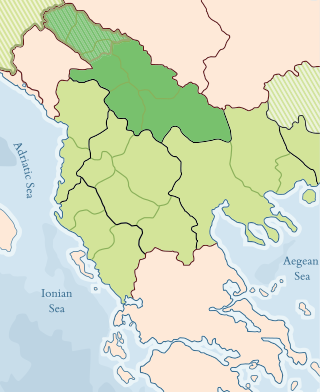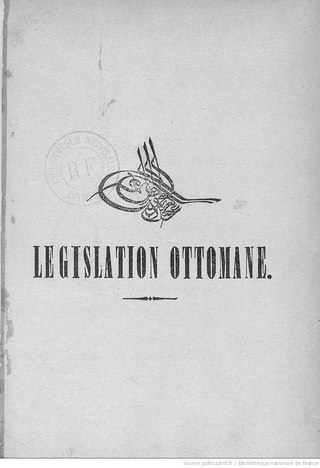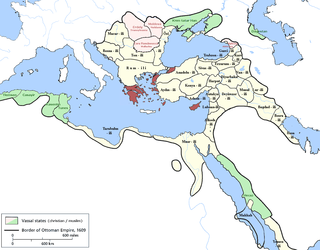
A sanjak was an administrative division of the Ottoman Empire. The Ottomans also sometimes called the sanjak a liva from the name's calque in Arabic and Persian.
The Ottoman Empire developed over the years as a despotism with the Sultan as the supreme ruler of a centralized government that had an effective control of its provinces, officials and inhabitants. Wealth and rank could be inherited but were just as often earned. Positions were perceived as titles, such as viziers and aghas. Military service was a key to many problems.

The administrative divisions of the Ottoman Empire were administrative divisions of the state organisation of the Ottoman Empire. Outside this system were various types of vassal and tributary states.

The Eyalet of Cyprus was an eyalet (province) of the Ottoman Empire made up of the island of Cyprus, which was annexed into the Empire in 1571. The Ottomans changed the way they administered Cyprus multiple times. It was a sanjak (sub-province) of the Eyalet of the Archipelago from 1670 to 1703, and again from 1784 onwards; a fief of the Grand Vizier ; and again an eyalet for the short period from 1745 to 1748.
A kaza was an administrative division of the Ottoman Empire. It is also discussed in English under the names district, subdistrict, and juridical district. Kazas continued to be used by some of the empire's successor states. At present, they are used by Iraq, Lebanon, Jordan, and in Arabic discussion of Israel. In these contexts, they are also known by the Arabic name qada, qadā, or qadaa.

Beylerbey was a high rank in the western Islamic world in the late Middle Ages and early modern period, from the Anatolian Seljuks and the Ilkhanids to Safavid Empire and the Ottoman Empire. Initially designating a commander-in-chief, it eventually came to be held by senior provincial governors. In Ottoman usage, where the rank survived the longest, it designated the governors-general of some of the largest and most important provinces, although in later centuries it became devalued into a mere honorific title. The title is originally Turkic and its equivalents in Arabic were amir al-umara, and in Persian, mir-i miran.
Ḥakīm and Ḥākim are two Arabic titles derived from the same triliteral root Ḥ-K-M "appoint, choose, judge".

The Vilayet of Kosovo was a first-level administrative division (vilayet) of the Ottoman Empire in the Balkan Peninsula which included the modern-day territory of Kosovo and the north-western part of the Republic of North Macedonia. The areas today comprising Sandžak (Raška) region of Serbia and Montenegro, although de jure under Ottoman control, were de facto under Austro-Hungarian occupation from 1878 until 1909, as provided under Article 25 of the Treaty of Berlin. Üsküb (Skopje) functioned as the capital of the province and the midway point between Istanbul and its European provinces. Üsküb's population of 32,000 made it the largest city in the province, followed by Prizren, also numbering at 30,000.

The Vilayet of Adrianople or Vilayet of Edirne was a first-level administrative division (vilayet) of the Ottoman Empire.

Mutasarrif, mutesarrif, mutasarriff, or mutesarriff was the title used in the Ottoman Empire and places like post-Ottoman Iraq for the governor of an administrative district in place of the usual sanjakbey. The Ottoman rank of mutasarrif was established as part of a 1864 reform, and its holder was appointed directly by the Sultan.

Ottoman Syria refers to divisions of the Ottoman Empire within the region of Syria, usually defined as being east of the Mediterranean Sea, west of the Euphrates River, north of the Arabian Desert and south of the Taurus Mountains.
North Macedonia was part of the Ottoman Empire for over 500 years, from the late 14th century until the Treaty of Bucharest in 1913. Before its conquest, this area was divided between various Serbian feudal principalities. Later, it became part of the Ottoman province or Eyalet of Rumelia. The name Rumelia means "Land of the Romans" in Turkish, referring to the lands conquered by the Ottoman Turks from the Byzantine Empire.

A vilayet, also known by various other names, was a first-order administrative division of the later Ottoman Empire. It was introduced in the Vilayet Law of 21 January 1867, part of the Tanzimat reform movement initiated by the Ottoman Reform Edict of 1856. The Danube Vilayet had been specially formed in 1864 as an experiment under the leading reformer Midhat Pasha. The Vilayet Law expanded its use, but it was not until 1884 that it was applied to all of the empire's provinces. Writing for the Encyclopaedia Britannica in 1911, Vincent Henry Penalver Caillard claimed that the reform had intended to provide the provinces with greater amounts of local self-government but in fact had the effect of centralizing more power with the sultan and local Muslims at the expense of other communities.

The Eyalet of Rumeli, or Eyalet ofRumelia, known as the Beylerbeylik of Rumeli until 1591, was a first-level province of the Ottoman Empire encompassing most of the Balkans ("Rumelia"). For most of its history, it was the largest and most important province of the Empire, containing key cities such as Edirne, Yanina (Ioannina), Sofia, Filibe (Plovdiv), Manastır/Monastir (Bitola), Üsküp (Skopje), and the major seaport of Selânik/Salonica (Thessaloniki). It was also among the oldest Ottoman eyalets, lasting more than 500 years with several territorial restructurings over the long course of its existence.

The Eyalet of the Islands of the White Sea was a first-level province (eyalet) of the Ottoman Empire. From its inception until the Tanzimat reforms of the mid-19th century, it was under the personal control of the Kapudan Pasha, the commander-in-chief of the Ottoman Navy.

The Mutasarrifate of Jerusalem, also known as the Sanjak of Jerusalem, was an Ottoman district with special administrative status established in 1872. The district encompassed Jerusalem as well as Hebron, Jaffa, Gaza and Beersheba. During the late Ottoman period, the Mutasarrifate of Jerusalem was commonly referred to as Palestine; a very late Ottoman document describes Palestine as including the Sanjak of Nablus and Sanjak of Akka (Acre) as well, more in line with European usage. It was the 7th most heavily populated region of the Ottoman Empire's 36 provinces.

The sanjak of Najd was a sanjak of the Ottoman Empire. The name is considered misleading, as it covered the al-Hasa region, rather than the much larger Najd region. It was part of Baghdad Vilayet from June 1871 to 1875, when it became part of the Basra Vilayet.

The 1864 Vilayet Law, also known as the Provincial Reform Law, was introduced during the Tanzimat era of the late Ottoman Empire. This era of administration was marked by reform movements, with provincial movements led largely by Midhat Pasha, a key player in the Vilayet Law itself. The Vilayet Law reorganized the provinces within the empire, replacing the medieval eyalet system.
İçil was the name of a sanjak in Turkey and the Ottoman Empire.

The Sanjak of Durrës was one of the sanjaks of the Ottoman Empire. It was named for its capital Durrës and was also known as the Sanjak of Durazzo from its capital's Italian name. The sanjak was composed of the kazas of Durrës, Tirana, Shijak, Kavajë, and Krujë. The Sanjak of Durrës formed the southern half of the Vilayet of Scutari. The northern half was the Sanjak of Scutari. Durrës Sanjak also bordered the sanjaks of Manastir and Dibra to its northeast and the sanjak of Elbasan to the east and south. Its western border was the Adriatic Sea. Its terrain is generally flat and plain. Only the eastern parts of the kazas of Tirana and Kavajë were mountainous.













